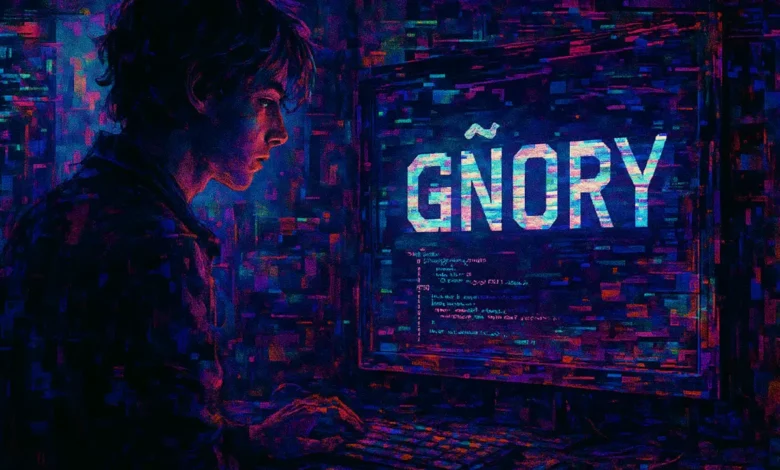Gñory: Exploring the Digital Philosophy Transforming Online Culture

In recent years, the digital landscape has witnessed the emergence of unique philosophies and aesthetic movements that challenge conventional norms. Among these movements, the gñory has captured the attention of creators, artists, technologists, and digital enthusiasts alike. Despite its relative novelty, gñory is rapidly becoming synonymous with a new era of digital expression, creativity, and mindful technology use.
What is Gñory?
Gñory (pronounced “nyo-ree”) is more than just a buzzword; it’s a comprehensive digital philosophy that encourages mindful, authentic, and emotionally resonant interactions with technology. Rooted in the underground digital art scene and coding communities, gñory is characterized by its embrace of glitch aesthetics, poetic coding, collective creative expression, and ethical disruption.
Rather than a specific platform or application, gñory represents a conceptual approach—one that emphasizes meaningful digital experiences over mindless consumption and superficial interactions. It seeks to restore depth, emotional authenticity, and human-centric values to an increasingly commodified digital world.
Origins and Meaning of Gñory
The gñory surfaced prominently around 2023 within niche coding and artistic communities online. Its unusual spelling and the presence of the tilde character (~) signify its departure from mainstream digital practices and typographic conventions. Although its exact etymological origins remain deliberately obscure, many associate it metaphorically with concepts like “gnosis” (knowledge) and “ory” (essence or nature), suggesting the “essence of knowing” or profound digital mindfulness.
The artistic collective behind its popularization initially introduced “gnory-os,” a synesthetic operating shell designed as a critique of traditional user experience (UX). It quickly gained a following among digital artists and experimental coders, who were drawn to its emotionally resonant and intentionally chaotic approach.
Core Principles of Gñory
Gñory is built upon five foundational pillars that collectively define its ethos:
- Imaginative Innovation: Gñory encourages breaking away from incremental, predictable changes in favor of creative, even chaotic innovation. It challenges digital creators to rethink conventional boundaries and experiment freely.
- Emotional Design: This philosophy places significant emphasis on creating digital experiences that evoke genuine emotional responses. Interfacing encourages engagement, provoking deeper interactions and facilitating meaningful experiences efficiently.
- Digital Mindfulness: A key principle of gñory involves intentional and conscious interaction with digital technology. It promotes the act of contemplation and slowing down for users to engage deeply with their digital experiences rather than passively consuming them.
- Collective Expression: Gñory thrives on community-driven creativity. It advocates for shared projects, open-source collaborations, communal digital art creation, and collective storytelling to foster deeper connections and understanding.
- Ethical Disruption: Balancing creativity and moral responsibility, gñory practitioners integrate concerns for digital privacy, autonomy, and resistance against surveillance and commodification into their work.
Gñory Aesthetic: Embracing the Glitch
Central to gñory’s identity is its distinctive “glitch” aesthetic. Glitches—unexpected, often visually striking errors—are deliberately incorporated to evoke emotional responses and disrupt conventional digital interactions. Instead of being viewed as flaws, glitches represent authenticity, imperfection, and human-like unpredictability.
Within gñory, glitch aesthetics manifest through:
- Poetic Coding: Code that resembles poetry, often with recursive or intentionally obfuscated elements designed to provoke curiosity and deeper exploration.
- Visual Disruption: Web designs and digital artworks featuring distorted visuals, broken typography, and deliberately unpredictable interactions.
- Audio Anomalies: Experimental digital music and soundscapes that incorporate unexpected sounds or disruptions, enhancing emotional depth.
These intentional imperfections aim to foster deeper emotional engagement, forcing users to pause and reconsider their interactions rather than passively scrolling or clicking through interfaces.
Gñory in Digital Art and Creative Expression
Gñory has significantly impacted various creative fields, particularly digital art, fashion, music, and user experience design.
- Digital Art: Artists employing gñory principles produce pieces that are visually chaotic yet profoundly meaningful, often showcased in virtual galleries, experimental NFTs, and digital installations.
- Fashion and Branding: Brands have adopted glitch aesthetics into apparel, merchandise, and visual identities, reflecting a conscious departure from slick, corporate branding towards authenticity and emotional resonance.
- Music and Audio Production: Gñory-influenced musicians integrate glitch sounds and intentionally disruptive audio patterns into their compositions, creating emotionally charged, unique listening experiences.
Community and Culture Surrounding Gñory
Gñory thrives in decentralized, community-oriented spaces—particularly niche Discord servers, GitHub repositories, and digital zines. Participants deliberately maintain anonymity or utilize digital personas, opting to avoid algorithm-driven platforms to preserve authenticity and resist commodification.
This cultural movement actively critiques mainstream digital practices by promoting genuine self-expression over polished, marketable identities. Its communities emphasize collaboration, experimentation, and shared creative experiences, often culminating in digital zine publications or collaborative online art projects.
Critiques and Challenges
Despite its compelling philosophy, gñory is not without its critiques. Common criticisms include:
- Elitism and Obscurity: Its cryptic nature and insider language can unintentionally alienate broader audiences, limiting accessibility.
- Commercialization Risks: The adoption of gñory aesthetics by brands or corporations risks commodifying and diluting its original intentions. Examples include “Gñory UX Packs” or branded glitch apparel, which threaten to strip away its underlying philosophical depth.
Supporters counter these criticisms by highlighting gñory’s continued resistance to full commercialization and its persistent niche status, arguing that its essence inherently rejects complete mainstream assimilation.
Future Directions and Potential Impact
The future of gñory appears promising yet intentionally uncertain. Its survival and growth depend significantly on maintaining its core values—emotional authenticity, digital mindfulness, collective creativity, and ethical awareness.
Potential future applications and directions include:
- Educational Integration: Art and design schools may increasingly adopt gñory principles, teaching students to incorporate mindful, emotionally resonant designs into their projects.
- AI and Generative Art: Gñory’s glitch aesthetics could be integrated with artificial intelligence, creating unpredictable, emotionally charged generative art forms that challenge traditional AI outputs.
- Virtual and Immersive Platforms: The development of immersive virtual spaces—such as VR-based digital art installations, interactive poetry zines, and collaborative digital hubs—can further propagate gñory ideals.
- Ethical Tech Initiatives: Tech cooperatives and activist groups might utilize gñory principles to advocate for more mindful, ethically responsible digital products and services, countering surveillance capitalism and digital exploitation.
Implementing Gñory in Your Digital Practice
For digital creators interested in incorporating gñory principles into their work, several practical methods include:
- Experiment with Glitch Techniques: Intentionally integrating glitches and unexpected behaviors into digital designs or interfaces can evoke stronger emotional engagement.
- Collaborative Projects: Creating community-driven digital art or writing projects helps foster collective creativity and strengthens emotional connections.
- Ethical Digital Practices: Prioritizing privacy, consent, transparency, and autonomy in digital creations aligns with gñory’s ethical framework.
Conclusion
Gñory represents an innovative digital philosophy emphasizing emotional depth, mindfulness, collective creativity, and ethical responsibility. Its intentional embrace of imperfections and disruptive aesthetics challenges mainstream digital norms, offering a refreshing alternative focused on authenticity and human-centric values.
As gñory continues to influence digital art, culture, and technology, it invites creators and users alike to rethink their digital interactions and embrace deeper, more meaningful engagements. Whether it remains a niche subculture or evolves into broader acceptance, gñory undeniably adds vital perspectives to contemporary discussions about technology, creativity, and digital authenticity.
You May Also Read: Haxillzojid54: The Digital Enigma That’s Capturing Online Curiosity




